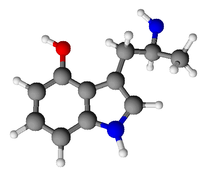4-Hydroxy-α-methyltryptamine (4-HO-αMT) is a psychedelic drug of the tryptamine class. It is a close structural analogue of α-methyltryptamine (αMT) and produces similar effects to it, but with exacerbated side effects similarly to 5-MeO-αMT. Alexander Shulgin describes 4-HO-αMT briefly in his book TiHKAL:[2]
 | |
 | |
| Clinical data | |
|---|---|
| Routes of administration | Oral |
| ATC code |
|
| Legal status | |
| Legal status |
|
| Identifiers | |
| |
| CAS Number |
|
| PubChem CID | |
| ChemSpider | |
| UNII | |
| CompTox Dashboard (EPA) | |
| Chemical and physical data | |
| Formula | C11H14N2O |
| Molar mass | 190.246 g·mol−1 |
| 3D model (JSmol) | |
| Melting point | 125–126 °C (257–259 °F) [1] |
| |
| |
| (verify) | |
The 4-hydroxy analogue of αMT has been looked at in human subjects. It is reported to be markedly visual in its effects, with some subjects reporting dizziness and a depressed feeling. There were, however, several toxic signs at doses of 15 to 20 milligrams orally, including abdominal pain, tachycardia, increased blood pressure and, with several people, headache and diarrhea.
— Alexander Shulgin, (TiHKAL)
See also
editReferences
edit- ^ Troxler F, Seemann F, Hofmann A (1959). "Abwandlungsprodukte von Psilocybin und Psilocin. 2. Mitteilung über synthetische Indolverbindungen". Helvetica Chimica Acta (in German). 42 (6): 2073–2103. doi:10.1002/hlca.19590420638.
- ^ "Erowid Online Books : "TIHKAL" - #48 a-MT".